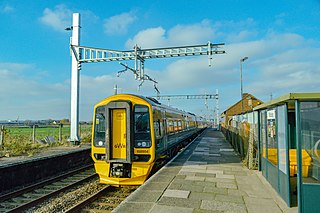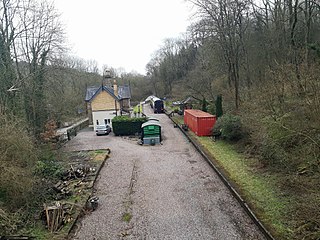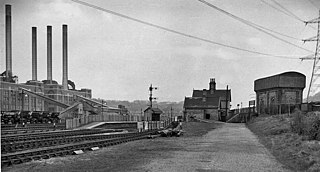
The Severn Valley Railway is a standard gauge heritage railway in Shropshire and Worcestershire, England, named after the company that originally built the railway over which it now operates. The 16-mile (26 km) heritage line runs from Bridgnorth to Kidderminster, following the course of the River Severn along the Severn Valley for much of its route, and crossing the river on the historic Victoria Bridge.

Pilning railway station is a minor station on the South Wales Main Line near Pilning, South Gloucestershire, England. It is 10 miles (16 km) from Bristol Temple Meads and is the last station on the English side before the Severn Tunnel through to Wales. Its three letter station code is PIL. It is managed by Great Western Railway, who provide the two train services per week from the station.

Hampton Loade railway station is a station on the Severn Valley Railway heritage line, close to the hamlet of Hampton on the western bank of the River Severn; Hampton Loade itself is on the eastern bank, and can no longer be reached by the Hampton Loade Ferry across the river as this has ceased operation.

Arley railway station is a station on the Severn Valley Railway heritage line in Worcestershire, situated just over the River Severn from the village of Upper Arley; a footbridge crosses the river to link the station to the village. The station is about 1⁄2 mile (0.8 km) north of Victoria Bridge, on which the SVR crosses the River Severn.

Highley railway station is a station on the Severn Valley Railway heritage line in Shropshire, near the west bank of the River Severn and just under a mile south-east of the village of Highley. Highley is the only staffed single-platform station on the line. Other stops with one platform are unstaffed halts.

The GWR Coalport railway station, active 1862–1963, was originally built as a single through platform railway station on the Severn Valley Line serving the village of Coalport in Shropshire, England. By January 1896 an additional platform had been added, thus permitting up and down trains to pass along, with a third platform face behind the up platform to form an east-facing bay. By this time, the goods sidings to the east of the station had been expanded.

Buildwas railway station was an isolated junction railway station on the Wellington to Craven Arms Railway and Severn Valley Railway. Opened on 1 February 1862. Although the station served both the Severn Valley Railway and Wellington to Craven Arms Railway, it was an interchange station in open countryside with no passenger access except by rail.

Ironbridge and Broseley railway station was a railway station with two through platforms on the Severn Valley Railway Line in Shropshire, England.

Linley, later Linley Halt, was a small railway station on the Severn Valley line in Shropshire, England.

Jackfield Halt was an unstaffed request stop on the Severn Valley line in Shropshire, England. Originally opened at Jackfield, west of Maw and Company's private sidings in 1934, it comprised a simple wooden platform and shelter.

Cressage railway station was a railway station on the Severn Valley Railway. It opened on 1 February 1862 with a single platform and a siding. By 1898 it had acquired an additional platform along with a signal box and the sidings had been expanded.

Eardington Halt, originally named Eardington, is a closed railway station on the Severn Valley Railway near Eardington, south of Bridgnorth, in Shropshire.

Parkend railway station is located in the village of Parkend, in the Forest of Dean, Gloucestershire. It is currently the northern terminus of the Dean Forest (heritage) Railway.

The Severn and Wye Railway began as an early tramroad network established in the Forest of Dean to facilitate the carriage of minerals to watercourses for onward conveyance. It was based on Lydney, where a small harbour was constructed, and opened its line to Parkend in 1810. It was progressively extended northwards, and a second line, the Mineral Loop was opened to connect newly opened mineral workings.

Alveley Halt was a halt on the original Severn Valley Line, situated between the villages of Highley and Alveley, in the English county of Shropshire. The station, which was not re-opened by the heritage Severn Valley Railway, has been replaced by the adjacent Country Park Halt around one-quarter of a mile (0.4 km) up the line.
Foley Park Halt was the first stop on the GWR Kidderminster to Bewdley loop line which now forms part of the Severn Valley Railway. It was located in the Kidderminster suburb of Foley Park where the railway went under the A451 Stourport Road. Facilities included a single wooden platform, a ticket booth and a Pagoda Platform Shelter.

Berkeley railway station served the town of Berkeley in Gloucestershire, England. The station was on the Sharpness Branch Line, part of the Midland Railway (MR), which connected the Bristol and Gloucester Railway main line at Berkeley Road station with the docks at Sharpness.
The Coleford Railway was a railway company that constructed a short railway from near Monmouth to Coleford, close to the Forest of Dean. The company was sponsored by the Great Western Railway. It was built on part of the course of the Monmouth Railway, a horse-operated plateway, and it was intended that its primary business would be the conveyance of minerals and forest products from the Forest of Dean.
Lydbrook Junction railway station is a disused railway station in England opened by the Ross and Monmouth Railway in 1873, it remained open for 91 years until 1964 when the line finally closed to freight, though passenger services ceased in 1959. The station was constructed in the hamlet of Stowfield approximately half a mile from Lydbrook and its viaduct on the Severn and Wye Railway. It was located approximately 4 miles and 34 chains along the railway from Ross-on-Wye station. In 1874 the Severn and Wye Railway opened a branch from Serridge Junction and Cinderford, passenger services commenced in 1875. All passenger trains along the S&W branch were withdrawn from 1929.

Stourport-on-Severn railway station was the main station in Stourport-on-Severn, Worcestershire, England.

















